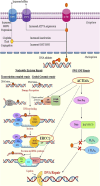A multimodal approach for establishing ACTL6A and ERCC1 as chemoresistance genes in locally advanced head and neck cancer
- PMID: 40510426
- PMCID: PMC12159016
- DOI: 10.3389/fphar.2025.1541987
A multimodal approach for establishing ACTL6A and ERCC1 as chemoresistance genes in locally advanced head and neck cancer
Abstract
Background: DNA is generally considered the ultimate target of cisplatin, so DNA repair has become the hallmark for cisplatin chemoresistance that is attributed to the poor overall survival (50%) among patients with head and neck cancer (HNC). As the efficacy of cisplatin is dose-dependent, we conducted the first study in an Asian population to characterize the DNA repair genes ACTL6A and ERCC1 based on the dosing of cisplatin-based chemoradiotherapy (CRT).
Methods: Locally advanced HNC (LAHNC) patients who were planning to undergo cisplatin-based CRT were enrolled in a prospective study to quantify the dose-dependent expressions of ACTL6A and ERCC1 from peripheral blood mononuclear cells via quantitative polymerase chain reaction; these results were integrated with computational analysis and systematic review/meta-analysis to formulate evidence-based translation decisions. The Friedman test and Wilcoxon's test were used to compare the expressions of the two genes before and after CRT, and Spearman's rank correlation was used to find the correlation between ACTL6A and ERCC1 expressions. All statistical analyses were performed using SPSS version 29.
Results: A total of 77 LAHNC patients were enrolled in this study, of which 96.1% were men and 3.9% were women with a mean age of 52.88 ± 9.68 years. The median expressions of ERCC1 were significantly increased (p < 0.001) after 50% (0.19) and 100% CRT (0.23) compared to the baseline value (0.14), whereas ACTL6A expression decreased from 4.77 to 3.87 after 50% CRT (p < 0.05) and increased to 5.43 after 100% CRT. From the computational analysis, ACTL6A and ERCC1 were found to be overexpressed among HNC patients and observed to regulate 10 repair pathways. Overexpressions of ERCC1 and ACTL6A were predicted to infiltrate the tumors with CD4+ cells, macrophages, dendritic cells, and B cells. The hazard ratios for overall survival were found to be 1.67 among the ACTL6A overexpressed and 1.82 among the ERCC1 overexpressed HNC patients via computational analysis and meta-analysis, respectively. Furthermore, FDA-approved drugs like gemcitabine and panobinostat were found to be the best candidates for downregulating ERCC1 and ACTL6A expressions based on binding affinities of -3.707 and -4.198 kcal/mol, respectively.
Conclusion: The increased expressions of ACTL6A and ERCC1 during/after cisplatin-based CRT are expected to mediate DNA repair leading to chemoresistance, which could result in poor overall survival in HNC patients. Thus, FDA-approved drugs like panobinostat and gemcitabine can be repurposed to target the chemoresistance genes ACTL6A and ERCC1, respectively.
Keywords: DNA repair; chemoradiotherapy; chemoresistance; cisplatin; drug repurposing; evidence.
Copyright © 2025 Chaudhary, Patil, Shetty, Mateti and Shetty.
Conflict of interest statement
The authors declare that the research was conducted in the absence of any commercial or financial relationships that could be construed as a potential conflict of interest.
Figures






Similar articles
-
ACTL6A promotes repair of cisplatin-induced DNA damage, a new mechanism of platinum resistance in cancer.Proc Natl Acad Sci U S A. 2021 Jan 19;118(3):e2015808118. doi: 10.1073/pnas.2015808118. Proc Natl Acad Sci U S A. 2021. PMID: 33408251 Free PMC article.
-
Influence of genetic markers on survival in non-small cell lung cancer.Drugs Today (Barc). 2003 Oct;39(10):775-86. doi: 10.1358/dot.2003.39.10.799471. Drugs Today (Barc). 2003. PMID: 14668933 Review.
-
ERCC1 and RRM1 gene expressions but not EGFR are predictive of shorter survival in advanced non-small-cell lung cancer treated with cisplatin and gemcitabine.Ann Oncol. 2006 Dec;17(12):1818-25. doi: 10.1093/annonc/mdl300. Epub 2006 Sep 15. Ann Oncol. 2006. PMID: 16980606
-
[Concurrent chemoradiotherapy (CRT) with S-1 and cisplatin (CDDP) in patients (pts) with locally advanced head and neck cancer (HNC)].Gan To Kagaku Ryoho. 2006 Jun;33 Suppl 1:167-71. Gan To Kagaku Ryoho. 2006. PMID: 16897996 Clinical Trial. Japanese.
-
Genetic testing for chemotherapy in non-small cell lung cancer.Lung Cancer. 2003 Aug;41 Suppl 1:S97-102. doi: 10.1016/s0169-5002(03)00151-x. Lung Cancer. 2003. PMID: 12867068 Review.
References
-
- Badola A., Mehta P., Mehra S., Sood S. (2023). Epidemiology and survival analysis of head and neck cancer: results from comprehensive care center in North India. Oral Oncol. Rep. 6, 100022–109060. 10.1016/j.oor.2023.100022 - DOI
-
- Bišof V., Zajc Petranović M., Rakušić Z., Samardžić K. R., Juretić A. (2016). The prognostic and predictive value of excision repair cross-complementation group 1 (ERCC1) protein in 1288 patients with head and neck squamous cell carcinoma treated with platinum-based therapy: a meta-analysis. Eur. Arch. Otorhinolaryngol. 273 (9), 2305–2317. 10.1007/s00405-015-3710-x - DOI - PubMed
LinkOut - more resources
Full Text Sources
Research Materials

